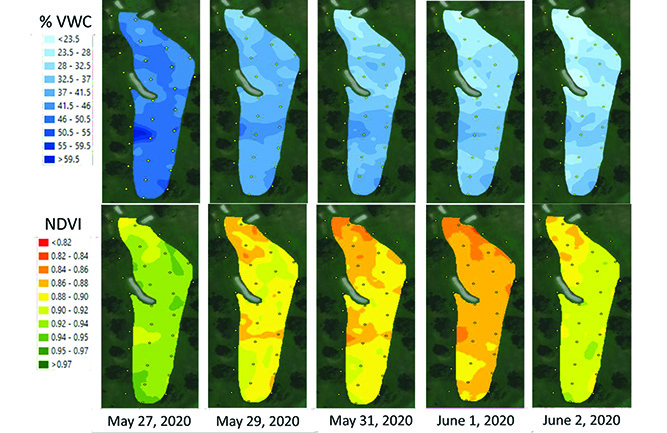Super Science Intro: Studying the benefits of precision irrigation
Researchers at Texas A&M University, University of Minnesota and The Toro Co. are evaluating the adoption of currently available soil moisture sensor (SMS) and mapping technologies. The goal is to see if golf course superintendents, with appropriate, actionable information, can make significant water and cost savings relative to ET-based and traditional irrigation scheduling methods.
This effort is the first on-course evaluation of soil moisture sensor and mapping technologies, and the knowledge gained will assist in creating practical protocols for implementing site-specific irrigation.

Kriged maps of volumetric water content (VWC) and normalized difference vegetation index (NDVI) on SMS treated fairway No. 5 throughout a dry down event from May 27 to June 2, 2020, at Edina Country Club in Minnesota (Photo by Chase Straw, Ph.D., Texas A&M University).
Nine fairways (six par 4s and three par 5s) at Edina Country Club in Minneapolis, Minn., were selected for use in the study and placed into groups of three based on size, soil moisture descriptive statistics and spatial maps of soil moisture variability.
Each grouping of three fairways is one replication in the study, and each fairway was one of three irrigation treatments initiated in 2020. Irrigation scheduling treatments include 1) SMS or soil moisture sensor-based irrigation scheduling, 2) ET-based deficit irrigation scheduling (three times per week, precipitation-adjusted, 60 percent of ET, Kc=0.98 and 3) traditional irrigation scheduling.
The researchers used the Toro PS6000 in 2019 to complete two golf course surveys for placing nine soil moisture sensors. Those surveys provided field capacity-based segmentation and classification (wet, average or dry) of fairways assigned to the SMS-based treatment. Toro TurfGuard in-ground SMSs were installed in August 2019. They placed one sensor in each soil moisture class within each replication.
Following 1.5 inches of precipitation, the researchers conducted a dry down of the fairways from May 27 to June 2, 2020. On the SMS fairways, irrigation was withheld to determine a lower threshold for triggering irrigation applications. They conducted routine PS6000 surveys during the dry down to monitor soil moisture and normalized difference vegetation index (NDVI) across all fairways (See maps, above).
The SMS-based irrigation scheduling approach achieved significant water savings. Due to the humid climate and the talent of the superintendent, the traditional scheduling approach used less water than the ET-based irrigation treatment.
The research has continued this year. Based on preliminary results from 2020, the expectation is that this project will define and demonstrate a workflow for implementing spatial mapping and SMS technology on a golf course. The work also will provide a case study that shows the substantial water savings generated by using such an approach. This information will benefit the golf industry and provide an essential tool for superintendents and water managers.












